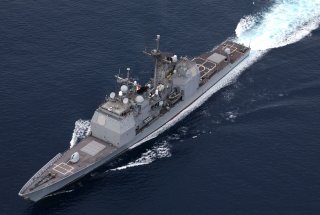What Makes China's "Mini Aegis-Class Destroyer" Special? No Sailors.
All robot?
Here’s a riddle: one ship carries missiles, radar and weighs 10,000 tons. The other carries missiles, radar and weighs twenty tons.
What do they have in common? They’re both Aegis-class warships, according to China.
Chinese media claims that China has developed a twenty-ton robot boat that is a “mini Aegis-class destroyer,” a bite-sized counterpart to the U.S. Navy’s vaunted Arleigh Burke-class destroyers. The American ships are equipped with the Aegis Combat System, which includes powerful radars as well as ninety to ninety-six Vertical Launch System tubes that can fire Tomahawk cruise missiles and an array of anti-aircraft, anti-submarine, anti-surface ship and even anti-ballistic missile weapons. Closer in size to cruisers than traditional destroyers, the 500-foot-long, 10,000-ton Arleigh Burkes can perform a variety of missions from land attack to ballistic missile defense.
China’s Mini-Me response is the JARI, developed by China Shipbuilding Industry Corporation and unveiled at a defense trade show in Abu Dhabi earlier this month. “The JARI unmanned surface vessel is equipped with a phased array radar, vertical-launched missiles and torpedoes despite its small size of 15 meters [49.2 feet] and low displacement of 20 tons,” said China’s state-owned Global Times, which cited an earlier Chinese state television report. “These weapons are usually only seen on frigates and destroyers with displacement of thousands of tons, and their use on a ship as small as the JARI makes the vessel the most integrated naval drone in the world.”
A photograph of a model of JARI showed what appeared to some kind of bow-mounted weapons mount with a cannon and launch tubes, what might be a single vertical launch tube amidships, and either outrigger booms or torpedo tubes attached to the stern.
“The ship can track naval targets within visual range, aerial targets 30 kilometers [18.6 miles] away and underwater targets 7 kilometers [4.3 miles] away,” Global Times said. “It can then attack with missiles, torpedoes and gun. The JARI can be remotely controlled, but also uses artificial intelligence to autonomously navigate itself and undertake combat activities once it receives commands.”
A Chinese military expert called the JARI a "mini Aegis-class destroyer. Given how small the ship is, this setup can be considered very powerful," he told Global Times.
By that thinking, mounting a gun on a scooter creates a mini Abrams tank. While robotics and miniaturization have made great strides, twenty tons versus 10,000 tons is more than a minor difference. For example, a twenty-ton boat probably can’t generate much electrical power, which in turn raises doubts about whether the JARI can operate a radar even a fraction as powerful as an American Aegis warship.
This writer has climbed aboard Sea Hunter, the U.S. Navy’s experimental robotic anti-submarine vessel. Even with a length of 132 feet, a displacement of about 145 tons and no crew quarters aboard, the vessel seemed hardly spacious for accommodating weapons and sensors. Barring a Chinese breakthrough in miniaturization, it would appear that JARI is limited in the number of weapons it can carry, the size of those weapons, and the sensors to support them.
Which may be just fine, as far is China is concerned. “Swarm boats,” in which hordes of manned or unmanned small craft overwhelm a large warship, have emerged as serious threats: Iranian swarm flotillas in the confined waters of the Persian Gulf worry the U.S. Navy, which itself is developing robotic wolfpacks. As a heavily armed and expendable crew-less attack boat, JARI has the potential to be an effective weapon, assuming that its AI algorithms are up to the challenge.
But when comparing an Arleigh Burke to an oversize combat dinghy, it is important to remember that what makes an Aegis-class warship effective is that it is a highly integrated system of weapons, sensors and trained human operators. Sticking some missiles and radar on a small boat does not an Aegis make.
Michael Peck is a contributing writer for the National Interest. He can be found on Twitter and Facebook.


